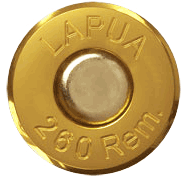Tests Show Lapua .260 Remington Brass is Very Uniform

 If you have a rifle chambered in .260 Remington, you may be wondering if the Lapua .260 Brass is worth the money compared to domestic-made brass. Well, the answer is “yes” if you demand consistent weight and dimensional uniformity (including neckwall thickness).
If you have a rifle chambered in .260 Remington, you may be wondering if the Lapua .260 Brass is worth the money compared to domestic-made brass. Well, the answer is “yes” if you demand consistent weight and dimensional uniformity (including neckwall thickness).
Mike Harpster of Dead Center Sports took the time to weigh and measure Lapua .260 Rem brass. His test show this brass to be extremely uniform. Weight variance was less than one (1) grain in a 20-case sample. And case neckwall thickness was very consistent.
Report by Mike Harpster: Lapua .260 Rem Brass Test Results (with Comparisons)
I pulled twenty (20) pieces randomly from one Lapua box to do some measurements. I weighed them on my Mettler-Toledo digital lab scale and here are the individual weights of each case. Remarkably, the Lapua brass had less than one grain total weight variance among all 20 cases!
While checking the Lapua brass I remembered I had just received some Winchester brand .308 brass, so I thought it would be interesting to do a comparison between the two brands. I again pulled 20 cases at random from a bag of 50 and repeated the same measurements. The results are shown in the right half of the table below.
Weight Variance Lapua .260 Rem Brass vs. Winchester-Brand .308 Win Brass
| LAPUA .260 Rem Brass | Winchester .308 Win Brass |

| 
|
| Average: 172.20 grains ES: 0.94 grains SD: 0.259 |
Average: 158.49 grains ES: 2.64 grains SD: 0.678 |
 Winchester Brass Further Inspection
Winchester Brass Further Inspection
The flash holes on the majority of the Winchester brass were not round or centered and they had large burrs inside. The neck wall thickness was pretty consistent, varying only .0015″ (.0125″ – .014″). As you can see in the photo (right) many of the Winchester cases were badly dented while the Lapua brass showed very few minor dents. The annealing on the necks of the Lapua brass was clearly evident while the Winchester showed no signs of being annealed. [Editor’s note: Winchester tumble-polishes its brass before shipping — so you would not notice annealing coloration if annealing had been done.]
Lapua Brass Further Inspection
With sample Lapua .260 Rem cases, I also measured the neck wall thickness in four places with calipers, not the most accurate method but I feel confident that the thickness did not vary more than .001″ over the 20 cases (.0145-.0155). The inside diameter of the neck measured .260 which would give .004 of neck tension out of the box. I visually checked the flash holes and I did not find any flakes of brass or burrs inside, the holes were round and centered.
Summary — This Lapua Brass is Impressive
I have never done these measurements on any other brass so I don’t know how they compare, but I am very impressed with the overall quality of the Lapua .260 brass. If they prove to hold up to the repeated firings I get from my Lapua 6BR brass I believe .260 shooters will be very happy.Mike Harpster — Dead Center Sports
105 Sunrise Drive
Spring Mills, PA 16875
phone: 814-571-4655
www.deadcentersports.com












 Lapua Brass Further Inspection
Lapua Brass Further Inspection OK, you .260 Rem shooters, break out your credit cards. The Lapua .260 Remington cartridge brass has finally arrived. Kevin Thomas of Lapua tells us: “Sorry for the wait guys, but it’s here. Grafs.com has its shipment and will begin shipping orders [May 4, 2011]. Kaltron Pettibone received theirs a few days ago and should be filling existing orders as I write. Let us know what you think of this stuff. Looks pretty good so far, but the proof’s in the pudding.”
OK, you .260 Rem shooters, break out your credit cards. The Lapua .260 Remington cartridge brass has finally arrived. Kevin Thomas of Lapua tells us: “Sorry for the wait guys, but it’s here. Grafs.com has its shipment and will begin shipping orders [May 4, 2011]. Kaltron Pettibone received theirs a few days ago and should be filling existing orders as I write. Let us know what you think of this stuff. Looks pretty good so far, but the proof’s in the pudding.” 
 Following SGT Sherri Gallagher’s record-setting victory in the 2010 NRA High Power National Championship, many readers have asked what caliber (chambering) Sherri was shooting. Well, Sherri was shooting a .260 Remington at all yardages, as confirmed by SFC Emil Praslick, USAMU rifle coach. Runner-up Carl Bernosky was shooting a 6mm Hagar in an AR-platform rifle.
Following SGT Sherri Gallagher’s record-setting victory in the 2010 NRA High Power National Championship, many readers have asked what caliber (chambering) Sherri was shooting. Well, Sherri was shooting a .260 Remington at all yardages, as confirmed by SFC Emil Praslick, USAMU rifle coach. Runner-up Carl Bernosky was shooting a 6mm Hagar in an AR-platform rifle. Accuracy Trumps Raw Velocity
Accuracy Trumps Raw Velocity





